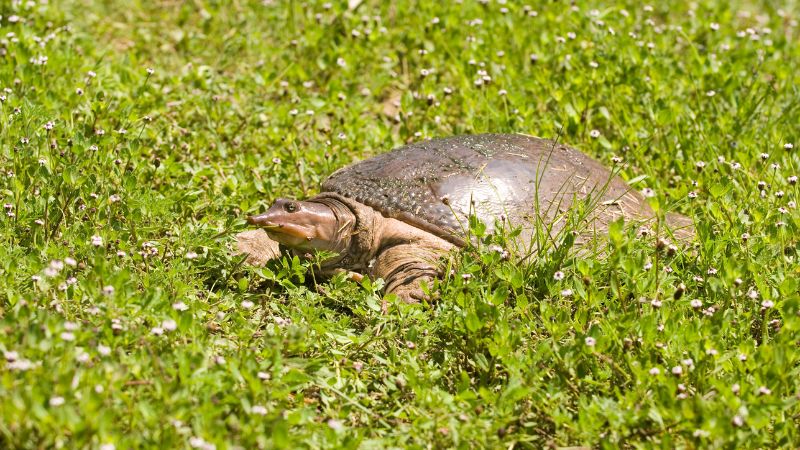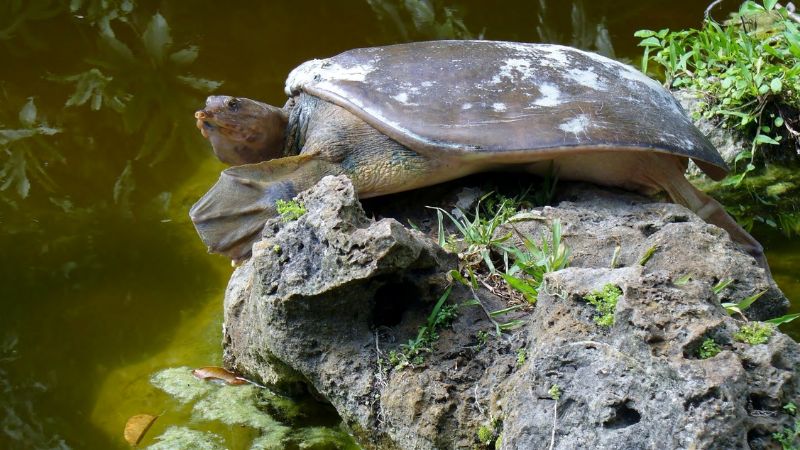Spiny softshell turtles are unlike any other turtle due to their unique soft and flat, “pancake-like” carapaces. However, this does not make them any less menacing as they’re known to pack a powerful bite and can become quite invasive.
So, how to get rid of spiny softshell turtles? The only efficient and practical way of doing so is to install baited hoop or funnel traps. These traps should be submerged underwater for the best results.
Read further this article to know more about spiny softshell turtles, how to properly identify them, and what you can do to prevent them from ever coming back!
What Are Spiny Softshell Turtles?

Unlike most turtles, spiny softshell turtles (Apalone spinifera) have soft, flat, and leathery carapaces that lack bony external plates and have flexible edges. Males have small spines on their shells.
They also have olive or tan bodies, long necks especially when fully extended, snorkel-like noses, two distinctive yellow stripes on the sides of their head, and dark edges surrounding their shells.
What Do Spiny Softshell Turtles Like?
Spiny softshell turtles like spending their time basking under the sun or burying themselves in mud at the bottom of freshwater environments with their heads visible on the surface.
What Do Spiny Softshell Turtles Eat?
They are opportunistic feeders, able to eat anything they can fit into their mouths. Their usual food items include insects, frogs, earthworms, and crayfish. They’re fast swimmers which helps them catch and consume small fishes occasionally.
Where Do Spiny Softshell Turtles Live?
Spiny softshell turtles inhabit central to eastern United States. They live in freshwater bodies such as lakes, rivers, farm ponds, marshes, and bays. They prefer habitats with open areas, a muddy or sandy bottom, and with little vegetation.
How Long Does Spiny Softshell Turtles Live?
This species has an estimated lifespan of up to 50 years in the wild, which is longer compared to other species in the same genus. Their longevity in captivity is unknown.
How Big Will Spiny Softshell Turtles Get?
Females can grow up to 18 inches in length and can weigh up to 15 kilograms while males only reach up to 9 inches and have an average body weight of 130 grams. Spiny softshell turtles reach mature size at 4 to 9 years old.
What Is the Behavior of Spiny Softshell Turtles?
Spiny softshell turtles are active during the day. They spend most of their time foraging and basking. These reptiles are able to breathe underwater for long periods of time.
The Pros and Cons of Spiny Softshell Turtles
Pros
Spiny softshell turtles are predators in aquatic food systems as they feed on aquatic insects and crustaceans. Hence, they are important members of freshwater ecosystems.
Cons
This species is considered to have a high risk of becoming invasive in freshwater environments. This is because they lay up to 40 eggs and produce up to 2 clutches in a year.
Related: How to Get Rid of Snapping Turtles | Essential Strategies!
Are Spiny Softshell Turtles Dangerous?

Yes, but only when they’re either intentionally bothered or accidentally mishandled. In these cases, they are known to extend their necks and bite. Despite not having beaks like other turtles, they are still capable of delivering painful bites.
Signs of Spiny Softshell Turtles Infestation
- Sightings of the turtles themselves
- Cloudy or dirty pond water
- Nests (holes) found in shores, sandbars, or loose soil
Why Would You Want to Get Rid of Spiny Softshell Turtles?
Getting rid of spiny softshell turtles means eliminating the chances of these reptiles multiplying in and making a home out of your property. You also reduce the risk of getting bitten by these creatures.
How to Get Rid of Spiny Softshell Turtles?

The most efficient and practical way of removing these reptiles from your property is by setting up a baited hoop or funnel traps. They can be purchased or constructed and are usually made out of mesh and chicken wire or nylon.
These traps work best when submerged underwater. The type of bait to use is not essential, it can be anything from chicken entrails, fish, and even cottonseed or soybean cake. Place fresh bait every 2 to 3 days.
How to Prevent Spiny Softshell Turtles From Getting Into Your Property?
To effectively prevent spiny softshell turtles from coming back into your property, simply follow these methods:
- Reduce aquatic plants and vegetation by using tools such as shovels and rakes. You can also use an aerator in the middle of your pond for more efficiency.
- Remove muddy or sandy bottoms by dredging your ponds or using a pond vacuum. Make sure the soil around ponds is compact enough to reduce the chances of the turtles burrowing and laying eggs in loose soil.
- Regularly check pond banks for any signs of turtle damage and burrows. Trim vegetation in these areas to reduce possible entry points for the turtles.
- Install a drift fence around your pond and a regular fence around your property to keep turtles from entering.
Related: How to Get Rid of Turtles | Proven Long-Term Solutions!
List of Sources
Bartholomew, P. (n.d.). Apalone spinifera: Gulf Coast Spiny Softshell.
Boser, S. (2023). Assessing Your Pond: A Checklist for Pond Owners and Managers.
Daniel, W. M., & Morningstar, C. (2023). Apalone spinifera.
Davis, J. T. (2013). Turtle Control in Farm Ponds.
Kansas Herpetofaunal Atlas. (n.d.). Spiny Softshell.
Montana Field Guide. (n.d.). Spiny Softshell – Apalone spinifera.
Pattillo, A. (2015). Manage Excessive Aquatic Plants in Ponds.
Tarter, A. (n.d.). Spiny Softshell (Apalone spinifera).
Washington Department of Fish & Wildlife. (n.d.). Spiny Softshell turtle (Apalone spinifer).
- How to Get Rid of Turtles | Proven Long-Term Solutions! - August 26, 2023
- How to Get Rid of Kingsnakes | Easy & Humane! - August 26, 2023
- How to Get Rid of Northern Water Snakes | Best Solutions and Preventative Measures! - August 19, 2023

